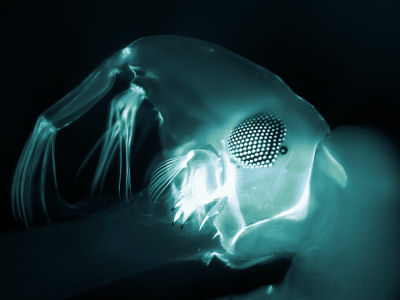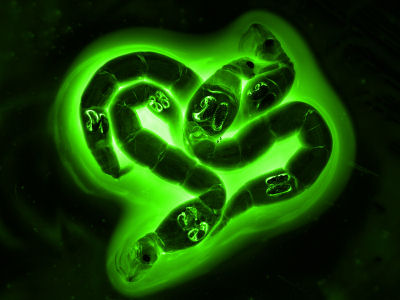| |
 |
"A Small Insect for Special Tasks"
"Larvae of Chaoborus sp. as an Indicator Organism"
JACEK FRANCIKOWSKI, MICHAŁ KRZYŻOWSKI, BARTOSZ BARAN
University of Silesia in Katowice, Faculty of Biology and Environmental Protection,
Department of Animal Physiology and Ecotoxicology, Bankowa 9, 40-007 Katowice
e-mail: jacekfrancikowski@wp.pl,
bartosz.m.baran@gmail.com,
michal.krzyzowski@o2.pl

Head of Chaoborus sp. larvae in UV light

Bodies of Chaoborus sp. larvae with pyranine (1)

Bodies of Chaoborus sp. larvae with pyranine (2)
|

|
Description popularizing the research project
In the depth of ponds and even garden pools, where water has not been changed for a long time, pairs of eyes are floating. They resemble the Cheshire cat, who vanished in thin air leaving his grin behind. The watery pairs of eyes, unlike the cat's grin, still keep their transparent selves. Just behind the eyes and on the other end of their bodies, tiny air bubbles can be seen, which keep the beholders afloat.
The eyes and the bubbles belong to larvae of glassworms, harmless cousins of mosquitoes. Their transparency is their way to avoid planktivorous fishes. Invisible for fishes, they are also invisible for their own prey. They hunt them floating motionless between the bottom and the surface. And only from time to time its stillness is interrupted with energetic contractions of the body. When a glassworm is in danger, the contractions become more frequent. When the danger is gone, the insect gradually comes back to its natural stillness.
Yet in ponds and lakes there are dangers one cannot run away from, e.g. when in the water there is a harmful chemical compound like: pesticides washed from fields, a mixture of detergents, left-over medicines, fuel or fertilisers. Presence of the harmful substances makes the young insects try to leave the polluted area. Usually there is nowhere to hide from the danger as the dissolved poison is already in every litre of water. Yet it is not only the attempt to hide that increases the contractions. Some substances irritate their nervous system causing a similar effect to caffeine in human blood system.
It is the trait of glassworms, researchers exploit. Observations of changes in behaviour of the small, merely up to 1 centimetre -long, creatures provides a lot of information about quality of their water habitat. Harmful substances cause stress, resulting in more intensive contractions than in clean water. Glassworms are also useful in forecasting ecotoxicological future as they can be used in testing new substances and assessing their potential harm to the ecosystem. So that glassworms and other water creatures did not disappear like the Cheshire cat.
Abstract
Larvae of Chaoborus sp. are organisms which live and develop in water. They are extremely sensitive to contamination of their environment. This feature makes them widely used as a bioindicator organism in basic research of water pollution. They are also used during Ecotoxi-cology Lab classes at the University of Silesia, to show students methods for aquatic monitor-ing and detecting anthropogenic pollutions. The photographs were taken when materials for students were being prepared. They were meant to introduce students to the physiology and morphology of the insects used during the lab classes.
|
|
Komitet Organizacyjny

Współpraca

Sponsorzy








Patronat medialny


|
 2006
2006
 2008
2008
 2010
2010
 2012
2012
 2014
2014



















